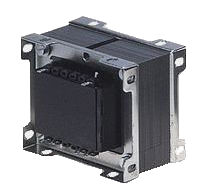Single Phase Theory

![Single Phase Voltage Transformer [Fig. 2]](transformer-spvt-01.gif)
![Turns Ratio Formula [Fig. 3]](transformer-turns-ratio.gif)
Transformers are capable of either increasing or decreasing the voltage and current levels of their supply, without modifying its frequency, or the amount of electrical power being transferred from one winding to another via the magnetic circuit.
A single phase voltage transformer basically consists of two electrical coils of wire, one called the “Primary Winding” and another called the “Secondary Winding”. For this tutorial we will define the “primary” side of the transformer as the side that usually takes power, and the “secondary” as the side that usually delivers power. In a single-phase voltage transformer the primary is usually the side with the higher voltage.
The two coil windings are electrically isolated from each other but are magnetically linked through the common core allowing electrical power to be transferred from one coil to the other. When an electric current passed through the primary winding, a magnetic field is developed which induces a voltage into the secondary winding as shown. [See Fig. 2].
In other words, for a transformer there is no direct electrical connection between the two coil windings, thereby giving it the name also of an Isolation Transformer. Generally, the primary winding of a transformer is connected to the input voltage supply and converts or transforms the electrical power into a magnetic field. While the job of the secondary winding is to convert this alternating magnetic field into electrical power producing the required output voltage as shown.
Notice that the two coil windings are not electrically connected but are only linked magnetically. A single-phase transformer can operate to either increase or decrease the voltage applied to the primary winding. When a transformer is used to “increase” the voltage on its secondary winding with respect to the primary, it is called a Step-up transformer. When it is used to “decrease” the voltage on the secondary winding with respect to the primary it is called a Step-down transformer.
However, a third condition exists in which a transformer produces the same voltage on its secondary as is applied to its primary winding. In other words, its output is identical with respect to voltage, current and power transferred. This type of transformer is called an “Impedance Transformer” and is mainly used for impedance matching or the isolation of adjoining electrical circuits.
Basically, to change the voltage in either the primary or secondary you change the number of coils, or number of times the copper is wrapped around the iron core. This is called a ratio. If you have 3 volts on the primary and the ratio is 3:1 or 3 to 1 the voltage on the secondary would be 1 volt.
Transformers are all about “ratios”. The ratio of the primary to the secondary, the ratio of the input to the output, and the turns ratio of any given transformer will be the same as its voltage ratio. In other words for a transformer: “turns ratio = voltage ratio”. The actual number of turns of wire on any winding is generally not important, just the turns ratio and this relationship is given. [See Fig, 3]
Another one of the transformer basics parameters is its power rating. The power rating of a transformer is obtained by simply multiplying the current by the voltage to obtain a rating in Volt-amperes, ( VA ). Small single phase transformers may be rated in volt-amperes only, but much larger power transformers are rated in units of Kilo volt-amperes, ( kVA ) where 1 kilo volt-ampere is equal to 1,000 volt-amperes, and units of Mega volt-amperes, ( MVA ) where 1 mega volt-ampere is equal to 1 million volt-amperes.
Power in the primary equals the power in the secondary.
It would be nice if transformers were 100% efficient, but they're not. Most transformers average 94% to 96% at full load, which is still pretty good.
Transformers come in all sizes and ratings. Consider the ones outside your home. The voltage being sent down the electric lines or coming in from generating plants are not the typical 120Vac or 220Vac you'd find in your home. Those voltages are average 200Kv up 750Kv. That is enough to kill you many times over.
![3 Phase Voltage and Currents [Fig. 4]](transformer-3P-Explanation-01.gif)
![3 Phase Transformer Example [Fig. 5]](transformer-3P-example-01.gif)
![3 Phase Delta - Wye [Fig. 6]](transformer-3P-delta-wye-01.gif)
![3 Phase Delta - Delta Connection [Fig. 7]](transformer-3P-delta-delta-01.gif)
![3 Phase Star - Star Connection [Fig. 8]](transformer-3P-star-star-01.gif)
![3 Phase Star - Delta-Wye Schematic [Fig. 8A]](3P-delta-wye-diagrams-01.jpg)
![3 Phase Distribution Schematic [Fig. 8B]](3P-volt-dist-schematic-01.jpg)
![3 Phase Square D Transformer Plate [Fig. X]](3P-square-d-xformer-15-kva-plate.jpg)
![3 Phase Full Load Current Table [Fig. Y]](Selection Chart for 3-Phase Transformer.png)
![60 Cycle Waveform [Fig. 9]](60-cycle-wave-01.jpg)
![3 Phase WaveForm [Fig. 10]](3P-wave-01.jpg)
![3 Phase Synchronous Motor [Fig. 11]](3P-synchronos-motor-01.jpg)
![3 Phase Induction Motor Equivalent Cuicuit [Fig. 12]](3P-induction-motor-schematic-01.jpg)
![3 Phase Induction Motor Simplified Cuicuit [Fig. 13]](3P-induction-motor-schematic-02.jpg)